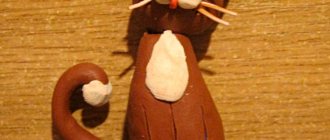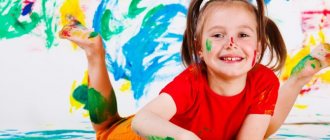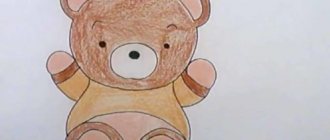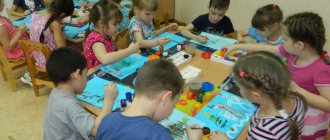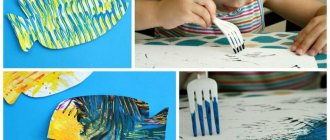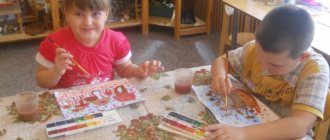Notes on drawing in a senior speech therapy group Topic: “Self-portrait”
Program content:
- Teach children to draw a self-portrait, conveying the features of their face in the drawing.
- Learn to position parts of the face correctly.
- To consolidate children's knowledge about the portrait genre, that the artist in a portrait conveys not only external resemblance, but also the inner world of a person, his character, mood.
- Develop the ability to draw on the entire sheet, using various art materials (pencils, felt-tip pens, wax crayons, watercolors).
- Cultivate an interest in drawing.
Integration of educational areas: speech development, cognitive development, artistic and aesthetic development, physical development. Material : mirrors, pencils, album sheet, illustrations, portrait reproduction, supporting drawings to show stages of work. Methodological techniques: Conversation, teacher's story, examination of illustrations with a portrait, use of literary words, individual work during the lesson, summing up. Dictionary: Portrait, self-portrait. Preliminary work: • Examination of portraits of artists and poets. • Consideration of thematic dictionary in pictures from the series “Human World” on the topic: “Parts of the body.” • Drawing portraits with a simple pencil. • Didactic game “Name it affectionately”, “Name the parts of the head”, “Name what a person has 2”, etc.
Progress of the lesson
Children stand in a circle and greet each other with a smile. Educator: Yesterday we had an exhibition of new paintings in our group. Who remembers what genre of painting they belong to? Children: To the “portrait” genre. Educator: Who will remind you what a portrait is? (Children's answers: A portrait is...) Educator: Who creates the portrait? Or maybe the artist can draw himself. Educator: This portrait will be called a self-portrait. A self-portrait is also a portrait, but only when the artist conveys his facial features, his character and mood in the drawing. Do you think it is convenient to paint a self-portrait from memory or by looking in the mirror? Children: Looking in the mirror, it will look more similar. Educator: Do you want to become an artist and learn to draw your own self-portrait? Now I will teach you. Let's look at the portrait of this boy so that you depict the eyes, nose, mouth on the face in the right places. — What is the best way to place a sheet of paper (vertically or horizontally)? — What shape is a person’s head? (I trace the head in the portrait with my finger. We make a sketch with a simple pencil, without pressing, so that the lines are thin and can be corrected with an eraser, I draw an oval on the sheet). Place your hand on your forehead. A person's eyes are located below the forehead, in the middle of the face. What shape are they? (oval with sharp corners, I draw the eyes, explaining that the distance between the eyes is small, no more than one eye. Inside the eye there is a colored circle and a small black pupil.) - What is above the eyes? (Eyebrows.) - The nose is located between the eyes, starts from the eyebrows, ends in the middle from the eyes to the end of the face. — From the tip of the nose to the end of the face, there are lips in the middle. - Children, look at each other. Do you see that the upper lip is different in shape from the lower? There are, as it were, two waves on the upper lip, and one on the lower lip (I draw the lips). - Below the lips is the chin. Place your hand on your chin. — We draw ears on the sides, they start at eye level and end at the level of the tip of the nose. To summarize: - Where are the eyes located? -Where is the nose located? - Lips? - Ears? The neck is narrower than the face, and the shoulders are wider than the head (I show it in the portrait). Look in the mirror for the color of your eyes, hair, hairstyle, and top of your clothes. Go to the tables, mirrors, your hands and diagrams will help you in your work; before you start working, let’s get our fingers in the working mood. Finger gymnastics “Friendship” In our group, girls and boys are friends. (connect your fingers in a “lock”) We will make friends with your little fingers. (touching the fingertips of both hands) One, two, three, four, five - start counting again. (paired touch of fingers from the little fingers) One, two, three, four, five - we finished counting. (hands down, shake your brushes) While drawing, you can look in the mirror to better and more accurately convey the features of your face. We try to draw in such a way that we can find out who is depicted in this picture. (during work, I give advice and help if necessary). At the end of the work, the children bring their drawings to the “Our Group” panel. Analysis. Did Styopa place his eyes, nose... correctly? Children, do you think your parents recognize you in self-portraits? Do you think Maxim (Kirill), your mother will recognize you? Why? Each of you tried to draw a self-portrait. I think all mothers will recognize you and admire your self-portraits. I draw your attention to the fact that we can make a portrait of the group, I suggest you cut out your self-portrait a little later and paste it on, and we will get a portrait of ours, which we will hang in the locker room.
Summary of the drawing lesson “Man in the works of artists. Drawing. Self-portrait"
Thus, a portrait is not just an image of a person; artists sought to convey the character of a person, his spiritual world, as well as the reflection in the portrait of the features of our history, our past.
Among the portraits in our exhibition there is an image of a person, where the artist depicted himself. Such a portrait is called a self-portrait.
Zinaida Sergeevna Serebryakova “Self-portrait”.
The artist depicted herself looking in the mirror.
- What can you tell about this person?
— What do the objects (background) lying nearby say?
It was a clear, sunny, winter day, from the light of which the objects on the table sparkled and shimmered with all colors. And she herself - young, happy, full of hope and enthusiasm, decided to stop this happy, beautiful moment - wrote her mood, open, pure look, radiant eyes. In the self-portrait, the Artist conveyed her inner state, her feminine image, its openness, purity and cheerfulness.
In order for an artist to paint himself as he really is, a certain amount of courage is required. Not everyone will dare to tell the truth about themselves. In a self-portrait, the artist strives not only for external similarity, but also for internal similarity, his attitude towards life, people, art.
— Would you like to try to draw yourself?
—Have you noticed that every person has his own facial features?
Now I will give you each a mirror, take a close look at the oval of your face, the shape and color of your eyes, the line of your eyebrows, the shape of your nose, lips and, of course, your hair color. Don't forget about ears, eyelashes, hairstyle. All the little things are important, because they reflect the character of a person.
2. Artistic independent activity of children.
Children, looking at themselves in the mirror, begin to depict a self-portrait.
During independent work, the teacher, if necessary, carries out individual work with the child to correct the creation of his image and give the most expressiveness to the self-portrait.
3. Final part.
We look at completed work.
Educator:
— Tell us how you portrayed yourself?
— Is it possible to learn from your self-portraits about your mood, about what kind of things you like to do?
Next, children are asked to create a mini-gallery of self-portraits in the group.
Application.
Diego Velasquez. Portrait of Infanta Margherita in a gray-pink dress.
(1599-1660), Madrid
Portrait of a girl. In a few years she will become empress. It is impossible to take your eyes off her beautiful fluffy dress, made of shimmering silk and lots of lace. However, the abundance and multitude of beautiful fabrics depersonalized the child. It seems that childhood is dripping from her face, because from early childhood she is taught to behave as befits a real empress.
Lesson summary “Self-portrait”
Lesson notes
"Self-portrait".
in senior group No. 5
Objectives: 1. To consolidate children’s knowledge about the “portrait” genre of painting.
2. Teach children to draw a self-portrait, to convey the features of their face in the drawing.
3.Promote the development of your own artistic creativity.
Previous work: conversation on the paintings “Self-Portrait”; examination of the paintings “Self-Portrait” by L. Slesarskaya, L. Netsvetaev, Yu. Korovin.
Material for the lesson: Reproductions of paintings by Ulyanovsk artists - Y. Korovin “Self-portrait”, L. Slesarskaya “Autumn self-portrait”, L. Netsvetaev “Self-portrait”. Colored pencils, A4 sheets, mirrors, diagrams of a person's face.
Progress of the lesson.
(Children go to the art gallery).
Host: Guys, we came to the art gallery again today.
— Where paintings by Ulyanovsk artists are presented to your attention.
-Let's go up to the paintings and look at them carefully.
(Dunno runs in, starts shouting loudly and pushing).
“Whoa, wait, Dunno, you can’t behave like that in an art gallery.”
Dunno: How is it possible?
Host: Now the guys will tell you.
Children: You cannot run, talk loudly, or touch paintings.
Dunno: Why can’t you run, touch pictures, talk loudly?
Dunno: What can you do in an art gallery?
Children: Look at pictures, talk quietly, etc.
Dunno: Well, I understand how to behave in an art gallery.
(Notes the inscription on the paintings).
- Av-por-tert, what are these guys?
Children: A self-portrait is when an artist draws himself.
Dunno: Guys, I liked these two self-portraits. Tell me about them.
Presenter: Well, Dunno guys will tell you about these paintings.
Lera (Arisha): In the picture - Lyudmila Yuryevna Slesarskaya. This self-portrait was painted by the artist in 2000. An adult woman dressed in a warm knitted dress looks at us from the portrait and holds a brush in her hands. She called her self-portrait “Autumn” because the artist loves autumn very much. Looking at the portrait, I can say that the artist is a very beautiful woman.
Marat (Arsen): In the picture - Lev Nikolaevich Netsvetaev. This self-portrait was painted by the artist in 1980. Hair and beard are streaked with gray, but not grey. He has bright eyes. They are insightful and look far ahead. When the artist painted his portrait, he was probably thinking about something important. Looking at the portrait, I can say that he is a wise man.
Dunno: How many new and interesting things I learned.
-I also want to be an artist and draw my portrait.
Host: For this Dunno, we need to go to the workshop.
(Children sit at tables).
Dunno: Oh, how am I going to draw a portrait, because I don’t know how to draw a face correctly.
Host: And Ksyusha will tell you about how to correctly draw your self-portrait.
Ksyusha: Here is an oval face, it looks like an egg
Now we will divide it in the middle with a thin line
Let's draw a line of hair, eyes and mouth.
We draw the eyes in an arc, arc towards each other, with a round pupil in the middle.
Draw a semicircle for the nose, dots for the nostrils
The lower lip is arched, the upper lip is dimpled.
Eyebrows are half-arched, ears are half-circles.
Presenter: Do you understand everything, Dunno? (Yes).
- There are mirrors on the tables in front of you, they are your assistants. If you forgot something about your appearance, you can look at it to remember.
(Children draw Self-Portraits).
Presenter: (Exhibition of children's works). Let's guys show our guests and Dunno what portraits you got.
-Well, Dunno, do you remember what “Self-Portrait” is?
Dunno: Yes, I remembered everything and now I will teach all my friends in the flower country to draw self-portraits. And in memory of our meeting, I want to give you a gift. (Book and puzzle).
-Thank you guys, see you soon.
Get text
Lesson summary in the middle group “Self-portrait” project (secondary group) on the topic
“Introduction to the art of portraiture “Self-portrait”
Goals:
- To consolidate children's knowledge about the genre of portraiture.
- Teach children to draw a self-portrait, convey it in a drawing
- features of your face.
- Learn to position parts of the face correctly.
- Use different methods of painting when drawing.
Materials: mirrors, felt-tip pen, pencils, album sheet, illustrations.
Methodological techniques: Conversation, teacher's story, looking at illustrations with self-portraits, using literary words, a surprise moment, individual work during the lesson, summing up.
Vocabulary: Portrait, self-portrait, miniature, profile, full face, front, etc.
Preliminary work:
- Examination of portraits of artists and poets.
- Consideration of thematic dictionary in pictures from the series “Human World” on the topic: “Parts of the body.”
- Drawing portraits with a simple pencil.
- Didactic game “Name it affectionately”, “Name the parts of the head”, “Name what a person has 2”, etc.
PROGRESS OF THE CLASS
- Guys, a surprise awaits you today. Close your eyes. (Children close their eyes, the teacher changes clothes). - Open your eyes, my grandchildren. It’s me who came to visit you, Grandma-Riddle.
What do you guys know about my riddle poems? Where there is a solution, there is an end. Whoever gives a clue is well done! Here's my first riddle:
1. Vanka-rising from the top The foreigner doll Cindy will see the fat girl in it. Well, my friend Sashka will see the dirty one in him. (Mirror)
That's right, that's right! You guessed it! It's like they've seen him somewhere! I came for a reason, I brought you Mirrors.
(The teacher hands out mirrors).
You, guys, try to solve my riddles. No one will tell you the answer, but the mirror will show them to you.
Grandma asks riddles and puts the answers (pictures) on the board.
2. He can be very different: Kind, harmful, Proud, important, Long, small, hunchbacked, Fat, thin, freckled. (Nose)
3. The animal has it on the top of its head, and we have it below the eyes. (Ears)
4. Two Egorkas live near the hill. They live together, but don’t look at each other. (Eyes)
5. They are not sown or planted, they grow themselves. (Hair)
6. Joy has a friend in the form of a semicircle. On her face she lives. Then she will suddenly go somewhere. Then she will suddenly return, sadness and melancholy are afraid of her. (Smile)
– Which word was the odd one out among your answers? Why?
D: The word smile was redundant, since the rest of the words are parts of the face.
- Well done, right! Today we will learn to draw our self-portrait. Guys, do you know what a self-portrait is? A self-portrait is when an artist conveys his facial features in a drawing; he looks in the mirror and draws himself. In the portrait, you and I draw the head and part of the torso (shoulders). Previously, when there were no cameras, artists painted portraits of people.
Consider reproductions of self-portraits: K. Bryullov, G. Ryazhsky, Z. Serebryakova, V. Tropinin.
Games “Post a portrait”, “Find and show”.
Self-portrait “My mood”.
(The teacher and the children look at the self-portrait.)
– Now take the mirrors in your hands and look at your reflection in the mirror. Pay attention to what color your hair is, long or short, what kind of nose, ears, eyes. Where are the eyes, tip of the nose, ears, mouth located on the face?
– Now take a felt-tip pen and try to draw your portrait on the mirror.
- Drew it, well done! Now we can start drawing our self-portrait on paper. While drawing, you can look in the mirror to better and more accurately convey the features of your face. We try to draw in such a way that we can find out who is depicted in this picture.
(During work, I give advice and help if necessary).
– They finished the work and brought me their drawings.
The teacher places all the work on easels. An exhibition is being held.
Bottom line
– Whose self-portrait did you like the most? – Who do you think is depicted here? Etc.
